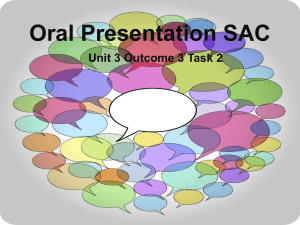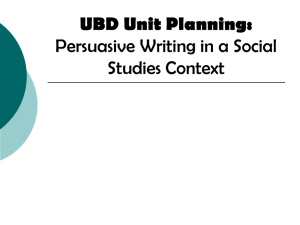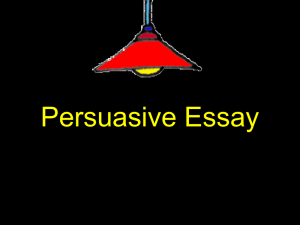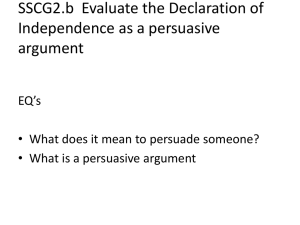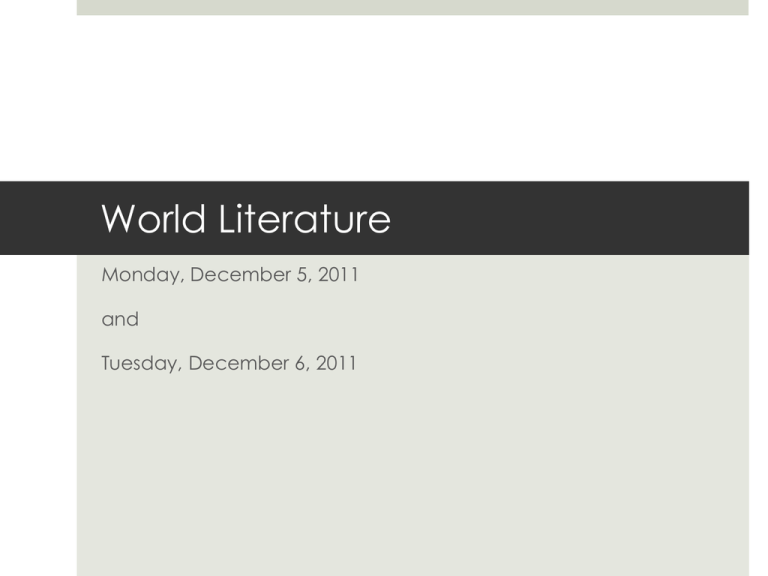
World Literature
Monday, December 5, 2011
and
Tuesday, December 6, 2011
Today’s Targets
Develop skills in persuasive writing
Using persuasive voice and selecting persuasive word
choice
Attacking the opposition through antithesis/rebuttal
Today’s Tasks
1.
Turn in warm-ups
2.
Finish finding evidence for paragraphs with your group
3.
Persuasive writing strategy review with small group
activities to develop skills
4.
HOMEWORK:
•
Write persuasive Odyssey paragraph and
antithesis/rebuttal paragraph
Turn in Warm-ups
1. Make sure your name is on them
2. Number them 1, 2, 3, etc.
3. Staple them together
4. Turn them in
Persuasive Writing – definition
In persuasive writing, a writer takes a position
FOR or AGAINST an issue and writes to
convince the reader to believe or do something.
The purpose is to get people to act, to support a
cause, make a change, build sympathy, agree
with your side, or prove something wrong.
Copyright © 2007 Washington Office of Superintendent of Public Instruction. All rights reserved.
Copyright © 2007 Washington
Office of Superintendent of Public
Instruction. All rights reserved.
Clear Position
In order to get others to agree with your argument, you
need to have a clear position and stay focused on it.
Persuasive Skill: Finding Evidence
• Is it relevant?
• Is it specific?
• How do I smoothly blend in my textual
evidence?
Group taskYou should had a thesis already. Find
evidence.
1.
Decide who will take which body paragraph point/claim.
2.
Write the topic sentence.
3.
Find evidence from the various texts and cite them.
4.
With quotes from a literary text, introduce the quote.
5.
After the quote, work in commentary to explain what the
quote or evidence means and how it proves your point.
6.
Use transitions between pieces of evidence.
Consider what makes effective evidence
Make sure that it is relevant
Be specific, not just general
Think facts, statistics, information from experts, anecdotes
Quote vs. Paraphrase (cite both)
Quote: When Odysseus and his men land on the island
with Helios’s cattle, he has his men “swear … a great
oath” that “any herd of cattle/ or flock of sheep here
found shall go unharmed;/ no one shall slaughter out of
wantonness/ ram or heifer; all shall be content/ with what
the goddess Kirke put aboard” (XII. 383-387).
When Odysseus and his men land on the island with
Helios’s cattle, he makes them promise that they will not
slaughter any of the island’s livestock and will only eat
the food from their ship’s stores which Kirke provided for
them (XII. 383-387).
How do I introduce a quote?
Consider who is talking, to whom, and about what.
Combine these in to a sentence.
When Odysseus and his men land on the island with
Helios’s cattle, he has his men “swear … a great oath”
that “any herd of cattle/ or flock of sheep here found
shall go unharmed;/ no one shall slaughter out of
wantonness/ ram or heifer; all shall be content/ with
what the goddess Kirke put aboard” (XII. 383-387).
Persuasive Skill: Commentary
• Elaborate on evidence
• Explain the evidence
• What does my evidence show and how does it show it?
Weaving in commentary
Commentary is used to
explain how the evidence you have provided proves your
point
Elaborate on the evidence by showing its connection to
your argument
Weaving commentary in with evidence
Odysseus employs a strong militaristic leadership style.
He does not ask for his men’s perspective but instead tells
them what they must do. For example, when Odysseus and
his men land on the island with Helios’s cattle, he has his men
“swear … a great oath” that “any herd of cattle/ or flock of
sheep here found shall go unharmed;/ no one shall slaughter
out of wantonness/ ram or heifer; all shall be content/ with
what the goddess Kirke put aboard” (XII. 383-387). He
pressures them to swear this oath and sets forth a powerful
directive that they are expected to follow rather than holding
a meeting to discuss their thoughts on the current situation.
Persuasive Skill: Attacking the opposition
• What is the opposition’s strongest
argument?
• How can I disprove the opposition’s
claim?
• How can I use evidence and explain
how the opposition’s interpretation of
that evidence is flawed?
Copyright © 2007 Washington
Office of Superintendent of Public
Instruction. All rights reserved.
Antithesis/Rebuttal
A reader of your essay is more likely to listen to you
if you show you can see his/her point of view before
you counter that argument.
The antithesis is when you acknowledge or consider
the opposing viewpoint, conceding something that
has some merit.
Rebuttal is when your own argument proves the other
side to be flawed, and shows your argument is
stronger.
Attack the opposition
In your antithesis/rebuttal paragraph.
Find the flaws.
Attack the opposition’s logic.
Consider a different way of viewing the evidence
and explain how it really supports your side and
not the opposing side.
This will strengthen your argument by showing your reader that
you see the other side and how the other side is not as valid as
your argument.
Identify antithesis and rebuttal
With your table partner, look at the antithesis/rebuttal
paragraph provided.
Underline the antithesis statement.
Circle the rebuttal claims.
Discuss how the paragraph attacks the arguments for the
opposition. Be prepared to share. I will call on folks at
random.
Antithesis/Rebuttal
Some say a dress code will reduce the number of cliques in
school and reduce discipline problems. Having a school dress code
might improve discipline, which might be true in schools where students
fight over shoes, but enforcing a dress code will generate even more
discipline issues than we have now and lead to student rebellion.
Students will quickly adapt and find new ways to express themselves and
their identification with their social groups. Hairstyles, piercings, and
tattoos will not just prove which group the student belongs to, but will
make students even more of a discipline problem when the tattoos
permanently express youth distress. We are still individuals and should be
allowed to express ourselves and be allowed our civil rights. There is
nothing more important to student than the ability to express their unique
sense of self. Whether it’s grunge, Goth, or glam, each student at our
high school is a person whose voice must be heard. Dress codes would
turn us all into a bland, uniform mass of white and navy. Student must
never be forced to wear uniforms for the school board’s convenience.
Copyright © 2007 Washington Office of Superintendent of Public Instruction. All rights reserved.
Return to the Odyssey prompt
With your group, go back to your original list of
reasons that support both sides.
Consider the opposing sides and their potential
evidence.
Now divide up each of the opposing arguments
among you. Each of you will write an
antithesis/rebuttal paragraph on a different
opposing point. Make sure that this point is not just
the opposite of the point you covered in your body
paragraph.
Write your own antithesis/rebuttal
Have each group member take one reason on the opposing side.
Make sure that it is not just going to address the exact opposite of
the reason you focused on in your original paragraph.
1.
Start with the antithesis statement. Make sure that there is a tag
phrase at the start to let your reader know that it is from the
opposing side. (“Some people may argue…” “While it may be
true that …” “While it may seem like …”)
2.
Use the rebuttal as an opportunity to add in a 4th argument or as
an opportunity to
Really work on attacking the opposing side by either providing
new, strong evidence to support a 4th argument or by pointing out
the flaws in the opposition or a different interpretation of the
evidence. (“While some may interpret ________ to mean that
_________, this actually supports the claim that ___________ by . . .”).
Persuasive Skill: Word Choice
• Is my word choice appropriate to my
audience?
• Is it specific and clear?
• Is it persuasive?
Review
We’ve covered evidence
Be specific.
We’ve covered commentary.
Explain, expand, elaborate.
We’ve covered antithesis and rebuttals.
State the oppositions strongest argument and attack it.
Now it is time to consider the words you choose.
Remember the Mary Maloney prompt. If you are addressing a
jury, you would want to use words like “police officer” instead of
“cop” or “lonely, loving wife” if you were defending her rather
than “cold, calculating killer” if were on the prosecution side.
Copyright © 2007 Washington
Office of Superintendent of Public
Instruction.
Persuasive Language
Persuasive language is choosing just the right words or phrases
to use at just the right time with just the right audience.
Strong words trigger strong feelings.
Seizes
Snarls
Dumbstruck
Effective choice of connotations
Mean or strict
Late fee or extended-viewing fee
Used or pre-owned
Surge or escalate
Repeated words or phrases for emphasis
I have a dream…(Martin Luther King, Jr.)
Copyright © 2007 Washington
Office of Superintendent of Public
Instruction. All rights reserved.
Persuasive Language –
Find Words that Could Be More Effective
I was a good high school student. One day, with an essay in one
hand, I went to class. “I’m done!” I smiled. The teacher took the
essay out of my hands and threw it away. She said, “It’s a day late!”
I look at my hard work. The teacher didn’t even look at it! The No
Late Homework Rule is bad.
Why is the word choice in this
Copyright © 2007 Washington
Office of Superintendent of Public
Instruction. All rights reserved.
Persuasive Language Example
I am a conscientious a high school student. One day, with a five
page essay in one hand, I rushed into the classroom. “I’m done!
I’m done!” I panted, beaming proudly. The teacher seized the
essay out of my grasp crumpled it into a ball and threw if
forcefully in to the recycle bin before me eyes. She snarled,
“It’s a day late!” I stared dumbstruck at all of my hard work,
balled up like a piece of trash. The teacher didn’t even glance at
it! The No Late Homework Rule is a cruel, horrible rule.
How does the word choice impact the power of this example
vs. the previous example?

